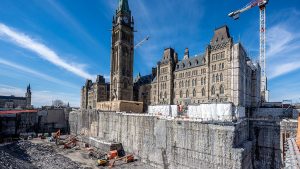In December 2019, Ontario’s On Site and Excess Soil Regulation came into law in support of improved management of excess soil. It’s known within the industry as
The concept behind R406/19 was to classify excess excavated soil as a valuable resource for possible reuse, not as garbage to be thrown away or sent to landfill. Possible reuse would include sites requiring active soil to build them up or for the rehabilitation of quarries.
Rules concerning soil management and reuse under R406/19 have been rolling out over the past five years. Amendments have also come out during that time.
Fundamental to the objectives of R406/19 was the , announced in March 2021.
The Ministry of the Environment, Conservation and Parks directed the to establish and maintain the registry. It would enable project leaders, owners and site operators to comply with R406/19 and would require the filing of notices for certain project areas, reuse sites and residential development soil depot sites where excess soil is generated, transported, temporarily placed and deposited. Compliance and enforcement would fall to the ministry.
Three types of registration are required: soils taken off-site; soils being received onsite; and temporary storage sites set up on adjacent land by residential developers.
The registry was envisioned as an important information and educational resource for the construction industry. One industry source likened it to “a dating site for soil.”
However, industry frustration is growing. Registration compliance is not occurring. It’s bad enough private companies are not complying with aspects of R406/19, but neither are many municipalities.
Industry sources have told the Daily Commercial News an initial analysis of registry figures indicates from Dec. 1, 2021 to June 6, 2024, there were 951 total registrations. Only half of those were for projects where soil was either being generated or received.
A closer look at municipal registrations reveals more.
There are 444 municipalities in Ontario. Yet, registrations occurred in only 149. Could this mean that during 30 months, nearly two-thirds of all municipalities in Ontario had no construction activity, either private or public, that would have been subject to registrations under R406/19? This seems unrealistically low.
“As a result, we really don’t have any true idea of the size and scope of this activity,” one source said.
Are municipalities unaware of the registration requirements, or are they knowingly ignoring them?
Municipalities have a say on how excess soil is handled within their jurisdiction by enacting site alteration bylaws and can issue permits on that basis.
Industry sources suggest site alteration bylaws can come in conflict with R406/19, causing “a disconnect” with provincial regulations. These local bylaws generally take the perspective of governing excess soil by putting the onus on the landowner where the excess soil is being deposited. However, R406/19 is very different. It puts the onus on the party generating the excess soil.
This shift should be forcing municipalities to site alteration bylaws. However, industry sources speak of resistance to change among smaller, less sophisticated municipalities, while others believe their site alterations bylaws exempt them from R406/19.
This disconnect between municipal and provincial regulations could leave municipalities vulnerable.
“If anything went awry, there could be considerable liability for the taxpayer,” one source said.
Making registration compliance more challenging are announced in April 2024. Fees for large volume projects generating 500,000 cubic metres or more jumped by 400 per cent to $150,000. Sites receiving large volumes had registry fees increase 350 per cent to $42,000.
The lack of provincial enforcement to correct the ongoing deficiency in registration compliance is frustrating for the soil management industry. It places the good players at a competitive disadvantage to those who flout the regulations.
Compliance and enforcement will become increasingly important as the final steps of R406/19 come into force at the end of this year. Those implications will be outlined in a future column.
John Bleasby is a Coldwater, Ont.-based freelance writer. Send comments and Climate and Construction column ideas to editor@dailycommercialnews.com.








Thanks for your article about the growing frustration among many industry stakeholders with the apparent lack of robust enforcement by The Government of Ontario with its own Excess Soil Regulations. Without the prospect of enforcement, these Regulations, which not only move excess soil management practices into the 21st century but lead to improved outcomes, amount to little more than hollow hardware.